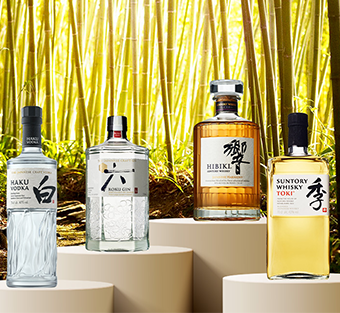
From silk dyeing and sword forging to woodblock printing, Japanese makers have always taken extensive pride in their craftsmanship. Even today, when the manufacturing of goods is often quick and cheap, Japanese artisans continue to be fastidious, unhurried, and highly skilled, honoring ancient techniques and traditions in their craft. The meticulousness that drives the craftsman’s spirit — shokunin kishitsu — continues to have wide-ranging influences in contemporary Japan. The single-minded devotion to one’s craft, patience for process, and pursuit of beauty can be seen in everything from Japanese gardens to cuisine: simple in appearance, yet complex in its making.
Kodawari, the Japanese pursuit of perfection and dedication to detail, lies at the heart of the culture’s traditional crafts, and it is what inspired the well-known House of Suntory to create Haku, a complexly flavored, delicate, and slightly sweet-tasting craft vodka spirit born from a simple grain of rice.
The Making of a Japanese Distillery
Haku has been years in the making — over half a century to be more exact. The first Suntory Vodka, Hermes Vodka, launched in 1956, but the origin of the House of Suntory dates back to 1899 when 20-year-old Shinjiro Torii set out to craft quintessentially Japanese spirits that reflected his culture’s ingenuity and fine craftsmanship.
Shinjiro was born during the Meiji Period, a time when Japan was emerging as a modern, industrialized nation with great power, influenced largely by Western ideas. Because of his early entrepreneurial spirit, Shinjiro entered into an apprenticeship at a young age at a pharmaceutical wholesaler in Osaka that carried Western liquors. He was taken by the sophistication of Western wines and spirits and sought to introduce them to the Japanese people. But that proved to be challenging; the strong, rich flavors didn’t appeal to the delicate Japanese palate. As such, Shinjiro ventured to thoughtfully blend imported wines to create a more pleasing flavor profile for his people. His meticulous layering of flavors and aromas eventually resulted in the launch of the widely popular Akadama Port Wine in 1907 (renamed Akadama Sweet Wine in 1973).
Shinjiro became highly skilled in the art of blending imported wines and liquors, but he was drawn to the idea of creating an authentically Japanese whisky that not only matched the quality of Scottish whisky but surpassed it. The House of Suntory broke ground on the country’s first malt whisky distillery in 1923, just outside of Kyoto. True to form, every decision was intentional, thoughtful, and in harmony with Japanese nature and culture. The location was carefully selected for its unique environmental qualities; nestled between Mount Tennozan and Mount Otokoyama where three rivers converge, the region provides a misty climate and some of Japan’s purest waters. Diverse temperatures and humidity also offer the ideal conditions for cask aging, known as the signature “Suntory Maturation” process that Suntory artisans still use today to create world-class whiskies.
Shinjiro’s son and successor, Keizo Saji, along with his son Shingo Torii, would go on to expand the House of Suntory with additional distilleries in Chita and Hakushu. Today, from a rice distillery in Kagoshima, master blender Kazuyuki Torii continues the family legacy and welcomes a new Suntory era with the addition of Haku; however, the old traditions, practices, and spirit of craftsmanship remain firmly in place.
Process Makes Perfection
Made with 100 percent Japanese hakumai (white rice), Haku is already in good company with the country’s traditional rice spirits, sake (brewed alcohol), and shochu (distilled liquor). The kanji (Japanese character) for Haku translates to “white,” but can also be read as “brilliance,” making it an apt name for a vodka made from white rice that also boasts exquisite clarity — all the more stunning with the bottle’s minimalistic, organic design reminiscent of a rippling stream.
The primary ingredient is simple, yet producing a craft vodka is anything but, once again invoking shokunin kishitsu — the craftsman’s meticulous spirit. Milled and polished to perfection, pure white Japanese rice yields a subtly sweet flavor and aroma. At the Osumi Distillery in Kagoshima, the white rice is fermented to create a mash, then distilled to create a rice spirit. It’s also distilled a second time to further enhance the flavor.
From there, the rice spirit is transported to Suntory’s Liquor Atelier in Osaka where it is blended and filtrated. The bamboo charcoal filtration system is one that Japanese culture has relied on for thousands of years to purify water. It was even said that the charcoal would “sweeten” the water for tea. The charcoal’s porous structure, with cavities three times more porous per gram than other wood charcoal, allows it to easily absorb most impurities — things that may detract from the vodka’s pristine clarity and smooth character.
The result is exactly what one has come to expect from Japanese craftsmanship: inspired innovation. And yet, it all comes back to that simple grain of rice. Haku craft vodka captures the delicate floral aroma and natural sweetness of the rice, and the sophisticated smooth flavor pleases the palate. Through careful attention to detail with an eye always toward the traditional spirit of perfection, Haku honors the finest of Japanese craftsmanship. True to form, it’s at once both artfully simplistic and profoundly complex — much like the rich culture that brings it to us.
This article is sponsored by House of Suntory.
Please drink responsibly, Haku® Vodka, 40% Alc./Vol. ©2022 Beam Suntory Import Co., Chicago, IL.
